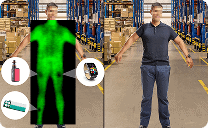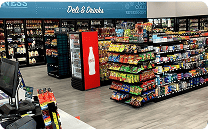Navigating Retail Franchise Opportunities: A Step-by-Step Guide to Successful Ownership
Retail franchising opportunities have been available to Americans since the late 19th century, promoting a core element of the American dream: to be an entrepreneur and own a business. In 2024, there were more than 3,000 distinct US franchising brands and approximately 831,000 franchise establishments in the US, generating a $897 billion impact on the US economy.
Determining the best can be a daunting challenge with so many franchise choices. Even the smallest investment in a franchise represents a substantial sum of money. The state of the US, the global economy, and geopolitical conditions can affect when to purchase and open a franchise. Some economists and franchise experts agree that 2025 is a good year for retail franchise opportunities. Forecasts indicate the US economy will continue to grow, the labor market is strong, consumers are still spending, and interest rates are expected to decrease during the year, making it easier to obtain financing.
Types of Retail Franchises
Retail franchises are a sub-group of business format franchises, one of the five primary types of franchises, the others being job franchises, product franchises, investment franchises, and conversion franchises. The product-franchise type also includes retail franchises, such as new car and marine dealerships, tractors, and heavy equipment.
Entrepreneurs who choose retail franchise opportunities receive a complete business format package: brand name, distribution rights, marketing strategies, management training, and long-term support. Within the retail-franchise sub-group, there are several franchise categories:
- Brick-and-mortar stores – are typical retail outlets found throughout most communities, including various store types (department, convenience). Restaurants are usually in this category. Franchisees will own or lease the store, market the location under the franchisor’s brand, and operate it according to the standards and procedures in the franchise agreement.
- E-commerce and online retail franchises—This franchise category often operates in the home or a small space without requiring a physical retail storefront. Franchisees typically manage the online storefront, inventory, and customer service. To succeed, franchisees must be thoroughly knowledgeable about online technology and marketing strategies.
- Health & wellness retail—Fitness studios, juice bars, supplement stores, and health food stores dominate this category of retail franchise opportunities. Franchisees need business knowledge and specialized training about the products and services in this category, which is also one of the fastest-growing categories.
- Specialty and niche retail—Successful franchisees in this category tend to be committed to the products they sell, such as specialty food, unique clothing, home décor, and hobbies. Strong customer loyalty is another success factor.
Key Factors to Consider When Choosing a Retail Franchise
The great variety of retail franchise opportunities means entrepreneurs will likely find a franchise category and business model that fits their lifestyle and business goals. With so many choices, however, future franchisees must methodically investigate and evaluate all aspects of the franchise package to protect their investment and maximize sustainability.
- Financial factors—Although all factors require careful consideration, financial factors, such as the initial investment and franchise fees, may most affect selecting a franchise.
- Market conditions and location – Before choosing a franchise, entrepreneurs want to understand the market conditions where they will do business, including competition, consumer base, physical store location, and expansion opportunities.
- Brand reputation – A new franchisee can be committed and enthusiastic about the opportunity and devote many hours to building the business, but is unlikely to succeed with a strong franchise brand. Another critical factor is learning how the franchisor supports other franchisees and their customers’ satisfaction.
- Franchise training and corporate support—The franchisor’s backing is equally important to all retail franchise opportunities. Successful franchisees receive comprehensive training for themselves and their employees and guidance on operations, marketing, and other business elements.
- Return on investment (ROI) – A franchise is an investment, so franchisees are also focused on the financial future of the franchise, including cash flow, profitability, the future market to sell it, and a targeted ROI.
Top Retail Franchise Opportunities in the US
Entrepreneurs’ research into retail franchise opportunities should include a thorough review of the current franchise landscape. These companies have a widespread market presence, legions of loyal and satisfied retail customers, a long record of profitability, above-average performance, and low-cost but profitable franchise opportunities.
- Well-established brands—Fast-food and casual restaurants, including McDonald’s, Domino’s Pizza, and Chick-fil-A, dominate these retail franchise opportunities. Convenience stores, such as 7-Eleven; hardware retailers, such as Ace Hardware; and service stores, such as The UPS Store, are other retail franchise opportunities with almost universal recognition.
- Fastest-growing franchises – Franchises with rapid growth appeal to prospective franchisees, but they should also tread carefully since fast growth can exhaust a franchise brand’s power. Resale clothing franchises, such as Kid to Kid, specialty food, Great Harvest Bakery Café, and car wash systems, such as Tommy’s Express, are worthy of consideration.
- Low-cost franchises – Entrepreneurs can typically operate these franchises, such as home inspection services and fitness instruction, from home. Others involve mobile operations, like carpet cleaning, windshield repair, and dog training. Many of these opportunities require only a modest initial investment—often just tens of thousands or even thousands of dollars.
How to Evaluate a Retail Franchise Business
Although future franchisees may be excited, even emotional, about the many retail franchise opportunities and are interested in a specific type and brand, they are best served by coldly evaluating the opportunity before investing time and money. Franchisees can start with the following points to create a franchise evaluation checklist:
- Stability of franchisor—Thorough knowledge of the franchisor’s financial health is crucial, and the place to start is reviewing audited financial statements. An abnormal number of past and current lawsuits and labor and operational violations is an indication of possible instability.
- Legal considerations – An attorney should thoroughly evaluate the Franchise Disclosure Document (FDD) and explain all the details to the future franchisee, including the terms and conditions, how to terminate the agreement, and whether they can sell or transfer the franchise.
- Additional fees and costs – When entrepreneurs consult with an attorney, they can uncover any required royalty payments to the franchisor. Attorneys can also identify agreements that require franchisees to buy goods and services from the franchisor or third parties, and help compare those costs to alternative sources.
- Current franchisees—Entrepreneurs considering retail franchise opportunities can protect their interests and assets by interviewing current franchisees in various locations. They should know if the franchisor’s support is fulfilling current franchisees’ expectations and if they have experienced any surprises or challenges.
Financing a Retail Franchise
Determining how to finance retail franchise opportunities is just as important as any other factor when deciding to become a franchisee. There are many funding sources, and seeking the advice of an attorney and an accountant will increase the likelihood of choosing the right one. Entrepreneurs should be prepared for initial costs of $20,000 to $1,000,000, depending on the franchise.
- Small Business Administration (SBA) – According to research from NerdWallet, an SBA loan for a franchise offers the largest maximum loan amount, at $5 million, and the lowest interest rates compared to many other sources. Again, the assistance of an attorney and accountant can make the process easier.
- Bank loans – Loaning money to new and old businesses is a core service of full-service banks. To qualify, however, a franchisee will likely need a strong credit history, contribute some of their assets, and present a comprehensive business plan with costs, marketing strategies, and revenue projections.
- Investors—In many cases, the primary investor in a retail franchise is the franchisee. The franchisee can use personal assets to cover all or part of the investment, but should seek professional advice. Investors could also be family and friends, or other entrepreneurs not interested in operating a business.
- Franchisors—Some retail franchise opportunity models may include franchisors’ loans or deferred payments. Franchisors want franchisees to succeed.
- Grants—Franchisees can also seek local, state, and/or federal grants to fund retail franchises. Eligibility requirements are standard.
Steps to Owning a Retail Franchise
The franchise ownership process can be complex and time-consuming. However, by understanding it thoroughly and with the guidance of an attorney and accountant, franchisees will find it easier and less stressful.
- Researching and selecting the right franchise—As detailed above, a proactive approach that involves learning about all the franchise retail opportunities, narrowing interest to a specific type, and spending quality time researching the franchisor and all the particulars is more likely to lead to success.
- Evaluating finances—After obtaining a short list of possible retail franchises, entrepreneurs should evaluate their financial situation, assets, and continuing personal/family financial needs and obligations to determine what sources to approach for funding.
- Completing the franchise application—Once franchisees perform due diligence on finances and funding sources, they can contact the franchisor and complete the application. Before signing any application or agreement, an attorney and an accountant should thoroughly review all documents. Franchisees should also understand all the terms, obligations, and additional costs besides the initial investment.
- Active operations – Depending on the retail franchise agreement, the franchisor may require new franchisees to participate in a training program, or franchisees may choose to attend voluntarily. After training, franchisees equip the store, receive inventory, hire staff, and prepare for the grand opening.
Common Challenges in Retail Franchising
Like any business, retail franchise opportunities come with many challenges, from staff issues to customer problems, vendor relations, and competition. If franchisees are well prepared for being new owners, have the complete support of the franchisor, and receive excellent guidance from an attorney and an accountant. They should be able to face any challenges, overcome them, and achieve long-term sustainability.
- Maintaining good business relationships—Franchisees’ success rate is directly related to their relationships with franchisors, vendors, and the local business community. Franchisors want honest feedback, and networking with other local businesses can have many benefits.
- Inventory management—Franchisees selling physical products need to manage inventory carefully. Customers expect the products to be available, including the newest trends, and vendors like to do business with franchisees who have control of their inventory. Supply chain issues may arise, but franchisees who are good inventory managers will suffer less.
- Franchise performance standards – As with most franchise agreements, franchisees must maintain certain standards: brand consistency and quality, sound financial stewardship, adhering to the law and regulations, solid staff management, and many others.
- Balancing franchisor requirements with local market conditions—In some retail franchise opportunities, complying with the franchise agreement details may be challenging in the local market where the franchise is located. This is another reason that the franchisee/franchisor relationship and open communications are critical.
Success Strategies for Retail Franchise Owners
After much research, evaluation, and preparation to choose and invest in a retail franchise and launch the franchise, franchisees must operate the business. The success strategies for retail franchise opportunities are almost identical to those for any retail establishment.
- Robust and proactive marketing—Every retail business relies on attracting customers, maintaining regular foot traffic, and increasing customer purchases. Achieving these goals requires a marketing program and promotions that penetrate the local consumer base and outmaneuver the competition.
- Hiring and training staff—Franchisees can’t expect to succeed without a dedicated staff that knows the products and services backwards and forwards, is familiar with and able to promote the franchisor’s brand, and provides superior customer service.
- Technological support—All franchises, even those operating in a physical setting, operate in the digital world. Greater efficiency, productivity, and profitability are more likely when franchisees utilize the many new technologies for communications, data collection and analysis, and inventory control.
- A focus on security—Shrinkage from shoplifting, employee theft, and fraud is the primary cause of retail loss, and franchisees can’t afford to skimp on security. Advanced technologies are also available to identify and catch thieves and maintain control of all business activities.
Conclusion
Retail franchise opportunities can be found in many countries. Still, they represent the independent American spirit and an economic system that allows many people to own a business. Almost any year is a good time to consider a retail franchise, but 2025 may be excellent. Entrepreneurs can choose from many franchise categories, with restaurants and retail stores having some of the most popular and profitable franchise opportunities.
Like any business startup, franchisees must carefully evaluate any franchise opportunity, seek funding sources, thoroughly understand the steps to owning a franchise, and prepare for the everyday challenges that most franchisees face. With the franchisor’s guidance and advice from an attorney and an accountant, retail franchise owners can implement many strategies, from marketing to a dedicated staff to excellent customer service, to maximize profitability and longevity. Contact us to learn more about our solutions, which have helped over 35,000 franchisees.
Frequently Asked Questions
Q: Why should someone consider retail franchise opportunities?
A: Entrepreneurs can choose from more than 3,000 distinct US franchising brands and find one that fits their interests, lifestyle, and financial goals. 2025 is forecast to be a good year to launch a franchise. The US economy and the labor market are strong, consumer spending is expected to increase, and interest rates will likely decrease during the year.
Q: What are some types of retail franchise opportunities?
A: Retail franchises are part of the larger business format franchise type. The primary franchise categories are brick-and-mortar stores, E-commerce and online retail franchises, health and wellness retail, and specialty and niche retail. The retail brand groupings include fast-food and casual restaurants, convenience stores, service stores, specialty food, car wash systems, carpet cleaning, windshield repair, and dog training.
Q: What are the advantages of owning a retail franchise?
A: Retail franchise opportunities are a good choice for someone who wants to be an entrepreneur but doesn’t want to invent a business from scratch. A franchise has support from the franchisor, and a business structure is already in place. Most franchises are known brands to consumers, so a new franchisee can spend less on marketing and advertising to promote the brand in the local market. The franchisor’s support includes management and employee training, access to financing sources, and networking with other franchisees in the system. Initial fees can be several thousand to one million, giving would-be franchisees a wide range of retail franchise opportunities.
Q: What are some common challenges to owning a retail franchise?
A: All business owners face common challenges, such as financial conditions, labor issues, and retail loss from shrinkage. Retail franchisees can experience other challenges unique to franchising. A good relationship with the franchisor is essential, and the data shows that the better the relationship, the more successful the franchisee. Franchise agreements include performance standards that the franchisee must maintain, such as brand consistency and quality. Sometimes, complying with franchisor marketing, branding, and promotional requirements is difficult for franchisees because of local market conditions.























